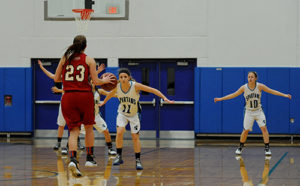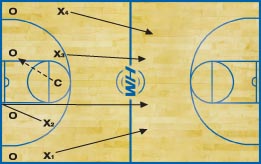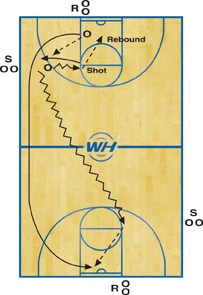‘Three-Stop Drill’ brings competitive edge to practices
This is a great defensive team drill to develop teamwork and discipline on defense, no matter the scheme you run. It’s a half-court drill that has the defensive team continuing to play defense until they get three stops.
 It’s a versatile drill, and one that gets the entire team involved. If you have 12 players on your team, you can use either four teams of three players or three teams of four players. Divide your team into squads that are fairly even from a talent standpoint so that the drill remains competitive. Have one coach work with the offensive team, and the other coach work with the defensive team. Another coach, or team manager, can keep track of the scoring (number of stops) and officiate.
It’s a versatile drill, and one that gets the entire team involved. If you have 12 players on your team, you can use either four teams of three players or three teams of four players. Divide your team into squads that are fairly even from a talent standpoint so that the drill remains competitive. Have one coach work with the offensive team, and the other coach work with the defensive team. Another coach, or team manager, can keep track of the scoring (number of stops) and officiate.
The purpose of the drill is to emphasize your team’s defensive philosophy. What do you want your team to accomplish in games? Where are you forcing the ball? How do you handle screens away from the ball? How do you handle screens on the ball? These are all important questions to ask when develop a scoring system for the drill. It should be based on defensive items that you give a high priority to in your program.
Drill rules
The offensive team brings the ball into play from half court to start drill. The defensive team needs to record three consecutive stops to get off defense. A defensive stop is considered any of the following accomplishments:
- Defensive rebound.
- Steal.
- Any deflection that leads to a recovery.
- Forcing an offensive violation.
- Drawing a charging foul.
Reasons to stay on defense
If any of the following occur, the defense stays on the floor and its score resets back to zero:
- The offense scores a basket.
- A player on defense commits a foul.
- The offense secures an offensive rebound.
- A player misses a box-out assignment while establishing defensive rebounding position.
- The defense allows an uncontested layup or shot (regardless of whether or not the shot was made).
- The defenders do not communicate on screens.
- There isn’t any defensive help on dribble penetration.
- Any of the defenders gives up on a play or demonstrates a lack of effort. The coach reserves the right to reset the score to zero for any reason.
The coach in charge of the drill decides what keeps a team on defense. The above reasons are what we follow in practice. The drill is very competitive, productive and simulates game-like intensity.
Play this drill twice a week. The “reward” for achieving three consecutive defensive stops is to get off the floor and then get a chance to go on offense. The longest our team has ever had a defensive team stay on the floor was 25 minutes.
Players must rely on one another to play solid defense and get out of the drill. You’ll find that there’s a lot of learning that occurs during this drill.
It’s been the most effective drill to reinforce our team’s defensive philosophy and prepare us for games.
Drill variations
This drill can be modified to include the defensive items that your coaching staff emphasizes. For example, our team occasionally institutes the following changes into this drill to keep things fresh and challenging for our players.
- The defending team works exclusively on either man-to-man or zone defense concepts.
- The offensive team is challenged to work on certain things such as scoring off the dribble penetrating all the way to the basket using screens etc.
You can also begin by having the defense play with a goal of two consecutive stops until it becomes more familiar with the drill. Or you can make the drill more difficult by instituting a stipulation that the defense must record four consecutive stops to get off the floor.
Insert your defensive team philosophy into this drill, and you’ll see it translate into your games.












